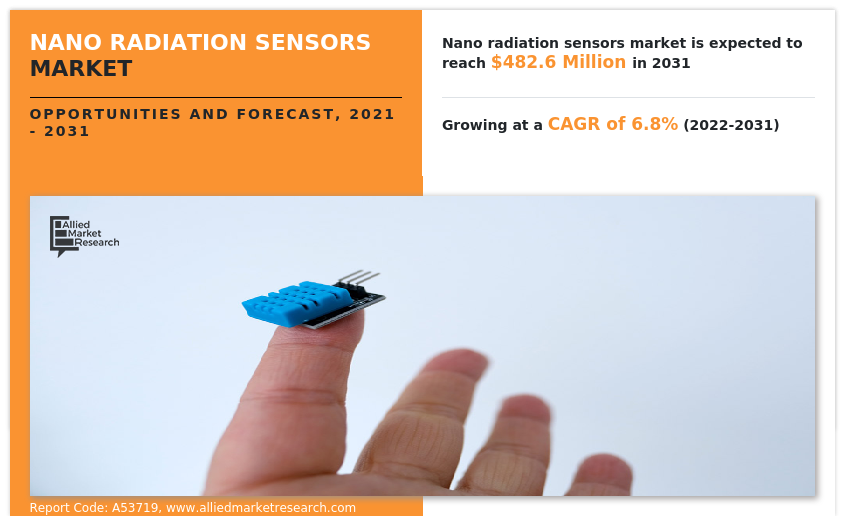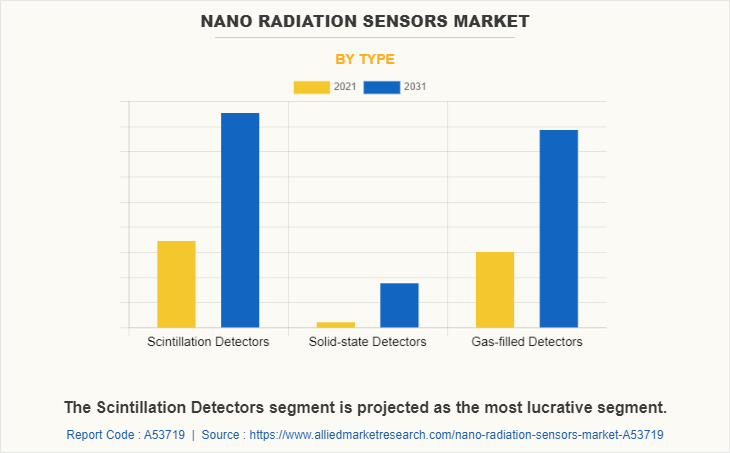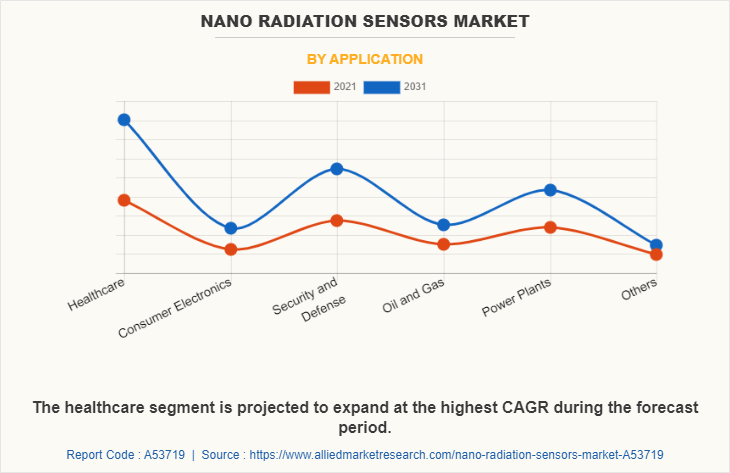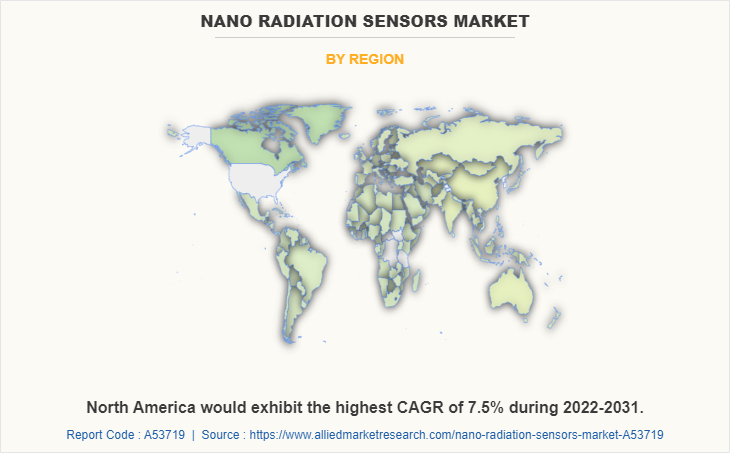Nano Radiation Sensors Market Research, 2031
The Global Nano Radiation Sensors Market was valued at $252.9 million in 2021, and is projected to reach $482.6 million by 2031, growing at a CAGR of 6.8% from 2022 to 2031.
Nano radiation sensors are devices that use nanotechnology to detect and measure various forms of radiation, such as alpha, beta, gamma, and neutron radiation. These sensors are designed to be highly sensitive and accurate, and they can be used in a wide range of applications, including nuclear power plants, medical imaging, and environmental monitoring.

The market for nano radiation sensors is expected to experience rapid growth due to an increase in demand for radiation detection and monitoring devices in various industries. The healthcare industry, in particular, is expected to be a major growth driver, as the demand for radiation therapy and imaging continues to increase. Radiation therapy and imaging are widely used in the diagnosis and treatment of cancer, and there is a growing demand for accurate and efficient radiation detection and monitoring devices. Nano radiation sensors offer several advantages over traditional sensors, including higher sensitivity and greater accuracy, which makes them particularly well-suited for use in medical applications.
Segment Overview
The nano radiation sensors market is segmented into Type and Application.
By type, the market is segmented into scintillation detectors, solid-state detectors, and gas-filled detectors.

By application, the market is categorized into healthcare, consumer electronics, security & defense, oil & gas, power plants, and others.

Region-wise, the nano radiation sensors market trends are analyzed across North America (the U.S., Canada, and Mexico), Europe (UK, Germany, France, and the rest of Europe), Asia-Pacific China, Japan, India, South Korea, and the rest of Asia-Pacific), and LAMEA (Latin America, the Middle East, and Africa).

Country Analysis
Country-wise, the U.S. acquired a prime share in the nano radiation sensors market in the North American region and is expected to grow at a significant CAGR during the forecast period of 2019-2031. The U.S. holds a dominant position in the nano radiation sensors market, owing to the rise in investment by prime vendors to boost the nano radiation sensors for consumer electronics and IT & telecom applications.
In Europe, Germany dominated the nano radiation sensors market share, in terms of revenue, in 2021 and is expected to follow the same trend during the forecast period. Germany is expected to emerge as the fastest-growing country in Europe's nano radiation sensors market with a notable CAGR, due to advancements in the automotive industry, which drives the usage of microelectronics in the country and thus creates lucrative opportunities for the nano radiation sensors market growth in Germany.
In Asia-Pacific, China is expected to emerge as a significant market for the nano radiation sensors industry, owing to new product developments and a significant rise in investment by prime players and government institutions. The well-established electronics industry in the Asia-Pacific region and the adoption of innovative technologies have given organizations in the region a competitive edge in the market.
In the LAMEA region, Latin America countries garnered significant market share in 2021 due to the adoption of new technologies, digital transformation, and connectivity are reshaping the future of the automotive and consumer electronics industry in Latin America. Moreover, the Middle East region is also expected to grow at a significant CAGR from 2022 to 2031, owing to shifts in artificial intelligence, industry 4.0, and smart technological changes in recent years, which are expected to reshape the growth of the nano radiation sensors in the Middle East region.
Nano radiation sensors typically consist of a small chip or film made from a material that can detect radiation, such as silicon, gallium arsenide, or diamond. The radiation interacts with the material and produces a signal, which is then detected and analyzed by the sensor. The use of nanotechnology allows for extremely precise control over the size and shape of the sensor, which can enhance its sensitivity and accuracy.
Nano radiation sensors use advanced materials and techniques such as graphene, carbon nanotubes, and quantum dots to detect radiation. They are highly effective in detecting ionizing radiation, which is harmful to human health and the environment. They are also capable of detecting other types of radiation, such as electromagnetic radiation, which is commonly used in medical imaging.
The Nano Radiation Sensors Market Outlook is expected to experience significant growth in the coming years, driven by advancements in nanotechnology and increasing awareness about the harmful effects of radiation exposure. Environmental monitoring is the area where nano-radiation sensors are expected to witness an increase in demand. There is a need for accurate and sensitive monitoring devices to track radiation levels in air, water, and soil, with growing concerns over the effects of radiation on the environment. Nano radiation sensors are ideal for this application because they can be integrated into small, portable devices that can be deployed in a wide range of environments. They can also be integrated into other systems, such as drones or robots, to enable remote sensing and monitoring of radiation levels in hazardous environments.
The global nano radiation sensors market is witnessing a surge in production capacity by manufacturers to meet the surge in demand from various industries such as automotive, consumer electronics, energy & utilities, defense & security, and industrial applications. Among these industries, the automotive sector has emerged as a particularly attractive target for investment in nanotechnology sensors due to the usefulness of nano sensors in airbag actuation, stability systems, and vehicle navigation applications. As a result, the market for nano radiation sensors is expected to witness a boost in demand from the automotive industry, particularly for safety purposes, which is likely to fuel the growth of the global nano radiation sensors industry during the forecast period.
Top Impacting Factors
The nano radiation sensors market is being driven by an increase in the importance of nano-radiation sensors in the field of nuclear surveillance and security due to the surge in frequency of terrorist activities involving nuclear materials and devices around the world. These sensors play an important role in detecting the presence of such substances and devices. Furthermore, the rise in demand for radiation sensor devices in nuclear medicine and cancer treatment applications fuels market growth. Despite these drivers, the high costs associated with developing and manufacturing nano-radiation sensors present a significant challenge for the market. However, the rise in interest in nuclear energy in emerging countries represents a promising growth opportunity for the nano radiation sensors market, as these countries offer potential growth opportunities for key players operating in the radiation sensors market.
Competitive Analysis
The global nano radiation sensors market is highly competitive, owing to the strong presence of existing vendors. Vendors of the nano radiation sensors market with extensive technical and financial resources are expected to gain a competitive advantage over their competitors because they can cater to market demands. The competitive environment in this market is expected to increase as product launches, agreements, and different strategies adopted by key vendors increase. Competitive analysis and profiles of the major global nano radiation sensors market players that have been provided in the report include First Sensor AG, Hamamastu Photonics K.K, Thermo Fischer Scientific Inc., Kromek Group PLC, Nihon Kessho Kogaku Company Ltd., Fluke Corporation, Baker Hughes (General Electric), Mirion Technologies, PCE Instruments, and Canon Electron Tubes & Devices Co.
Key Developments/ Strategies
According to the latest nano radiation sensors market forecast, Thermo Fischer Scientific Inc., Hamamatsu Photonics K.K., First Sensor AG, Mirion Technologies, and Baker Hughes (General Electric) are the top 5 key players in the nano radiation sensors market. Top market players have adopted various strategies, such as product launches and agreements, to expand their foothold in the nano radiation sensors market.
In December 2022, Kromek Group PLC signed a distribution agreement with Smiths Detection, a global leader in threat detection and security screening technologies. Under the terms of the agreement, Smiths Detection markets and distributes the Group’s wearable radiation detection and identification solutions in the Middle East and certain key markets in Asia and Australasia.
In March 2021, Canon launched the new Built-in AEC assistance technology for digital radiography. With this technology, the device's X-ray image sensor uses real-time detection of the pixel value corresponding to emitted X-rays, notifying the X-ray generator when the pixel value reaches a preset value.
Key Benefits For Stakeholders
- This report provides a quantitative analysis of the market segments, current trends, estimations, and dynamics of the nano radiation sensors market from 2021 to 2031 to identify the prevailing nano radiation sensors market opportunity.
- The market research is offered along with information related to key drivers, restraints, and opportunities.
- Porter's five forces analysis highlights the potency of buyers and suppliers to enable stakeholders to make profit-oriented business decisions and strengthen their supplier-buyer network.
- In-depth analysis of the nano radiation sensors market segmentation helps determine the prevailing market opportunities.
- Major countries in each region are mapped according to their revenue contribution to the global market.
- Market player positioning facilitates benchmarking and provides a clear understanding of the present position of the market players.
- The report includes the analysis of the regional as well as global nano radiation sensors market trends, key players, market segments, application areas, and market growth strategies.
Nano Radiation Sensors Market Report Highlights
| Aspects | Details |
| Market Size By 2031 | USD 482.6 million |
| Growth Rate | CAGR of 6.8% |
| Forecast period | 2022 - 2031 |
| Report Pages | 293 |
| By Type |
|
| By Application |
|
| By Region |
|
| Key Market Players | Fluke Corporation, Canon Electron Tubes & Devices Co., NIHON KESSHO KOGAKU CO., LTD., PCE Instruments, Hamamastu Photonics K.K, Baker Hughes (General Electric), First Sensor Ag, Thermo Fischer Scientific Inc., Mirion Technologies Inc., Kromek Group PLC |
Analyst Review
The growth of the nano radiation sensor market is driven by increase in product usage in various industries such as automotive, consumer electronics, and power generation. Surge in adoption of nanotechnology is expected to significantly boost the market growth during the period. Moreover, the increase in focus on technological advancements may create lucrative opportunities for players operating in the global market during this period. Research & development (R&D) in the market is likely to boost prospects for nano sensors, as new applications and capabilities emerge in radiation detection, radiation safety, and homeland security.
The Nano Radiation Sensors Market is expected to grow at a CAGR of 6.77% from 2022 to 2031.
The leading application of nano radiation sensors is in the healthcare industry, particularly in medical imaging and radiation therapy.
North America is currently the largest regional market for Nano Radiation Sensors.
The estimated industry size of Nano Radiation Sensors is expected to reach $482.62 million by 2031.
The top companies to hold the market share in Nano Radiation Sensors are Thermo Fischer Scientific Inc., Hamamastu Photonics K.K, First Sensor AG, Mirion Technologies, and Baker Hughes (General Electric)
Loading Table Of Content...
Loading Research Methodology...



